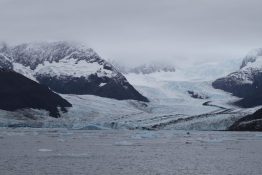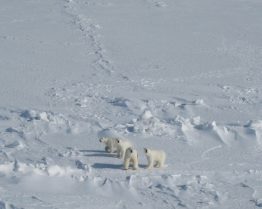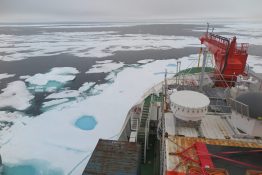An oceanographer at the University of Washington is part of a new project to study how glacial particles, created as glaciers grind the rock beneath them into a powder, react with seawater to remove carbon dioxide from the atmosphere. Alex Gagnon, an associate professor of oceanography at the UW, is one of the investigators on a newly funded project that involves field and lab studies of a natural setting that could help us understand the ocean’s role in carbon removal, which many experts believe will need to be combined with emissions reductions to address climate change.
Read more at UW News »Sustaining polar bear populations in the face of climate warming
Polar bears capture the imagination like few other wild animals. Adorable and roly-poly as snow-white cubs, they grow into massive hunting machines, supremely adapted to the harsh landscapes of the Arctic. Iconic the world over, many of us only dream of the chance to see one outside of the zoo. Polar bears have also become a symbol of an environment that’s changing unfavorably.
Read more »Official recognition of Southern Ocean brings Earth’s total to five
Growing up, most of us learned there were four oceans making up 71% of earth’s surface: The Arctic, Indian, Pacific and Atlantic. Now, there are five. The Southern Ocean is the most recent addition, officially recognized by National Geographic in June of 2021 on World Ocean Day. While the other four oceans are defined by continental boundaries, the Southern Ocean is different: it is the only ocean connecting the other oceans through a current that circles the entire globe.
Read more »Last ice-covered parts of summertime Arctic Ocean vulnerable to climate change
In a rapidly changing Arctic, one area might serve as a refuge — a place that could continue to harbor ice-dependent species when conditions in nearby areas become inhospitable. This region north of Greenland and the islands of the Canadian Arctic Archipelago has been termed the Last Ice Area. But research led by the University of Washington suggests that parts of this area are already showing a decline in summer sea ice.
Read more at UW News »Edge of Pine Island Glacier’s ice shelf is ripping apart, causing key Antarctic glacier to gain speed
For decades, the ice shelf helping to hold back one of the fastest-moving glaciers in Antarctica has gradually thinned. Analysis of satellite images reveals a more dramatic process in recent years: From 2017 to 2020, large icebergs at the ice shelf’s edge broke off, and the glacier sped up. Since floating ice shelves help to hold back the larger grounded mass of the glacier, the recent speedup due to the weakening edge could shorten the timeline for Pine Island Glacier’s eventual collapse into the sea.
Read more at UW News »





